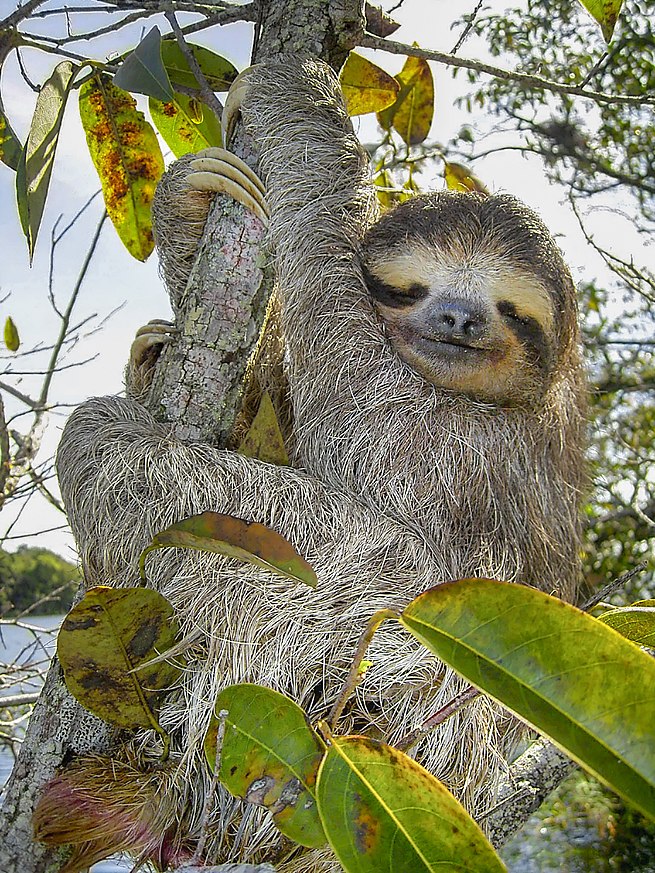Main Difference
The main difference between Sloth and Koala is that the Sloth is a suborder of mammals and Koala is a marsupial.
-
Sloth
Sloths are arboreal mammals noted for slowness of movement and for spending most of their lives hanging upside down in the trees of the tropical rainforests of South America and Central America. The six species are in two families: two-toed sloths and three-toed sloths. In spite of this traditional naming, all sloths actually have three toes. The two-toed sloths have two digits, or fingers, on each forelimb.The sloth is so named because of its very low metabolism and deliberate movements, sloth being related to the word slow. This is an evolutionary adaptation to their low-energy diet of leaves, and to avoid detection by predatory hawks and cats who hunt by sight. Sloths are almost helpless on the ground but are able to swim. The grooved hair of the sloth’s shaggy coat is a host to symbiotic green algae which helps the sloth camouflage itself in the trees, and provides nutrients to the sloth. The algae also nourishes sloth moths, some species of which exist solely on sloths.They are classified in the order Pilosa along with the anteaters. Extinct sloth species include many megafaunal ground sloths, some of which attained the size of elephants, as well as marine sloths.
-
Koala
The koala (Phascolarctos cinereus, or, inaccurately, koala bear) is an arboreal herbivorous marsupial native to Australia. It is the only extant representative of the family Phascolarctidae and its closest living relatives are the wombats. The koala is found in coastal areas of the mainland’s eastern and southern regions, inhabiting Queensland, New South Wales, Victoria, and South Australia. It is easily recognisable by its stout, tailless body and large head with round, fluffy ears and large, spoon-shaped nose. The koala has a body length of 60–85 cm (24–33 in) and weighs 4–15 kg (9–33 lb). Pelage colour ranges from silver grey to chocolate brown. Koalas from the northern populations are typically smaller and lighter in colour than their counterparts further south. These populations possibly are separate subspecies, but this is disputed.
Koalas typically inhabit open eucalypt woodlands, and the leaves of these trees make up most of their diet. Because this eucalypt diet has limited nutritional and caloric content, koalas are largely sedentary and sleep up to 20 hours a day. They are asocial animals, and bonding exists only between mothers and dependent offspring. Adult males communicate with loud bellows that intimidate rivals and attract mates. Males mark their presence with secretions from scent glands located on their chests. Being marsupials, koalas give birth to underdeveloped young that crawl into their mothers’ pouches, where they stay for the first six to seven months of their lives. These young koalas, known as joeys, are fully weaned around a year old. Koalas have few natural predators and parasites, but are threatened by various pathogens, such as Chlamydiaceae bacteria and the koala retrovirus, as well as by bushfires and droughts.
Koalas were hunted by indigenous Australians and depicted in myths and cave art for millennia. The first recorded encounter between a European and a koala was in 1798, and an image of the animal was published in 1810 by naturalist George Perry. Botanist Robert Brown wrote the first detailed scientific description of the koala in 1814, although his work remained unpublished for 180 years. Popular artist John Gould illustrated and described the koala, introducing the species to the general British public. Further details about the animal’s biology were revealed in the 19th century by several English scientists. Because of its distinctive appearance, the koala is recognised worldwide as a symbol of Australia. Koalas are listed as Vulnerable by the International Union for Conservation of Nature. The Australian government similarly lists specific populations in Queensland and New South Wales as Vulnerable. The animal was hunted heavily in the early 20th century for its fur, and large-scale cullings in Queensland resulted in a public outcry that initiated a movement to protect the species. Sanctuaries were established, and translocation efforts moved to new regions koalas whose habitat had become fragmented or reduced. The biggest threat to their existence is habitat destruction caused by agriculture and urbanisation.
-
Sloth (noun)
Laziness; slowness in the mindset; disinclination to action or labour.
-
Sloth (noun)
A herbivorous, arboreal South American mammal of the families Megalonychidae and Bradypodidae, noted for its slowness and inactivity.
-
Sloth (noun)
A collective term for a group of bears.
-
Sloth (verb)
To be idle; to idle (away time).
-
Koala (noun)
A tree-dwelling marsupial, Phascolarctos cinereus, that resembles a small bear with a broad head, large ears and sharp claws, mainly found in eastern Australia.
-
Sloth (noun)
reluctance to work or make an effort; laziness
“he should overcome his natural sloth and complacency”
-
Sloth (noun)
a slow-moving tropical American mammal that hangs upside down from the branches of trees using its long limbs and hooked claws.
-
Sloth (noun)
a group of bears
“the pair had been attacked by a sloth of bears”

